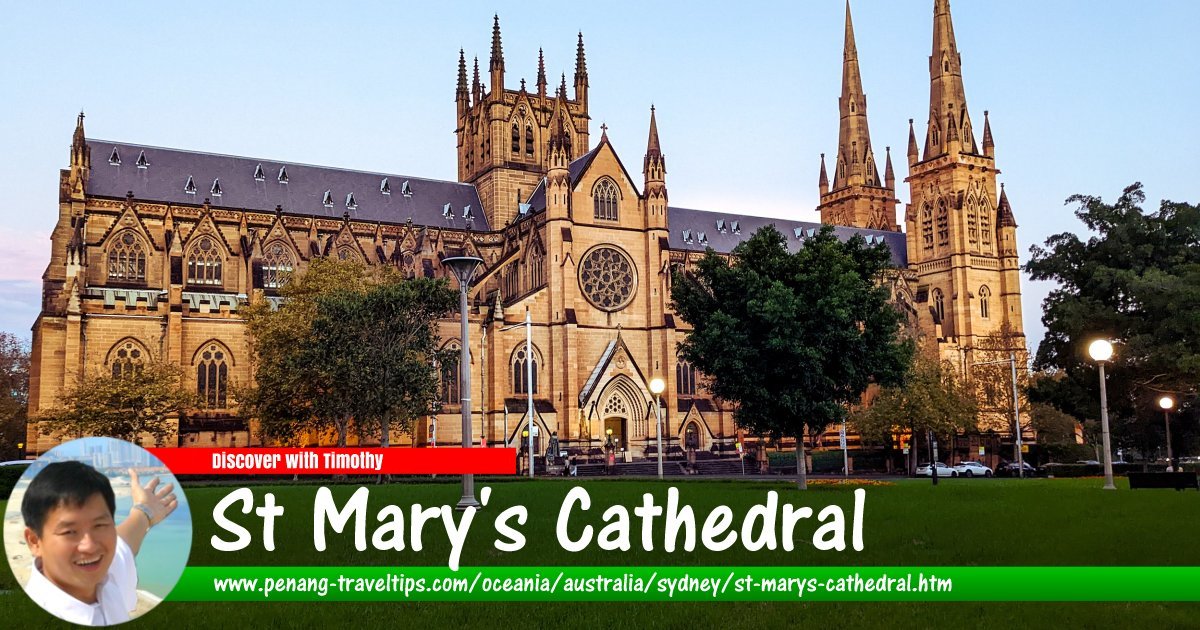
 St Mary's Cathedral, Sydney
St Mary's Cathedral, SydneyDxwkx, CC BY-SA 4.0, via Wikimedia Commons
St Mary's Cathedral (GPS: -33.87119, 151.21332) is the largest church building in Australia and reputedly one of the largest Roman Catholic church buildings in the Southern hemisphere. It is the seat of the Roman Catholic Archbishop of Sydney, presently Cardinal Archbishop George Pell. The cathedral is dedicated to "Mary, Help of Christians", Patron of Australia. St Mary's Cathedral holds the title of a minor basilica, bestowed upon it by Pope Pius XI in 1930. It St Mary's Cathedral is located on College Street in the heart of Sydney, and is one of the landmarks of the city.
At the time Sydney was colonised, there was no provision for the religious needs of convicts and settlers who were Roman Catholic. Reverent Father O'Flynn travelled to New South Wales to redress this, but because he came without government approval, he was sent back. It was only much later, in 1820, that Reverend Father John Joseph Therry arrived in Sydney, with official approval, to minister to the Roman Catholics of Sydney.
Father Therry applied to the government for land to build a church. He asked for a plot on the western side of Sydney, near Darling Harbour, but was instead given a piece of land towards the east, adjacent to a number of Governor Lachlan Macquarie's projects, including the Sydney Hospital, the Convict Barracts and St James Anglican Church. The site overlooks a barren piece of land where bricks were made. That barren brickfield is today Hyde Park.
 The interior of Sydney's St Mary's Cathedral
The interior of Sydney's St Mary's CathedralSource: https://commons.wikimedia.org/wiki/File:SaintMarys_CathedralSydney.jpg
 Adam J.W.C.
Adam J.W.C.
The foundation stone for the first St Mary's Cathedral was laid on 29 October, 1821, by Governor Macquarie. It was just a simple cruciform stone structure. The first Archbishop of the Roman Catholic Church of Australia was the Most Reverend John Polding in 1835.Father Therry died on 25 May, 1864. On 29 June, 1965, just over a year after, the first church caught fire and was destroyed.
Archdeacon Reverend Father McEnroe began a fund raiser to rebuild it. Impressed by the design of St John's College at Sydney University, archbishop Polding wrote to its architect, William Wardell, giving him a free hand to design the church. He told him to design, "any plan, any style, anything that is beautiful and grand ..."
While waiting for the permanent church to be completed, a temporary wooden structure was put up. It too was destroyed by fire, in the summer of 1869. In its place was another temporary provision, a brick building. It stood well and served as St Mary's School after the cathedral was completed.
Archbishop Polding laid the foundation stone for the present cathedral in 1868. It was to be a massive project which Polding never lived to see. He died in 1877, but it was another five years before the present St Mary's Cathedral was ready for use. It was opened on 8th September 1882, with Polding's successor, Archbishop Vaughan presiding at the Dedication Mass. He passed away in England the following year, 1883.
On Australia Day in 2000, the remains of Archbishop Vaughan was brought back to Sydney to be buried within the Chapel of the Irish Saints. This richly decorated crypt enshrines the remains of early priests and bishops. It was only completed in 1961. Spires were also added in 2000 to complete William Wardell's design (as the cathedral's towers were squared off until then).
Unlike most of the large cathedrals of the world, St Mary's Cathedral is oriented in the north-south direction rather than the usual east-west. The liturgical East End is at the north and the West Front is to the south.
St Mary's Cathedral is  on the Map of Sydney, Australia
on the Map of Sydney, Australia
Back to Discover Sydney
 Latest updates on Penang Travel Tips
Latest updates on Penang Travel Tips
About this website

Dear visitor, thank you so much for reading this page. My name is Timothy Tye and my hobby is to find out about places, write about them and share the information with you on this website. I have been writing this site since 5 January 2003. Originally (from 2003 until 2009, the site was called AsiaExplorers. I changed the name to Penang Travel Tips in 2009, even though I describe more than just Penang but everywhere I go (I often need to tell people that "Penang Travel Tips" is not just information about Penang, but information written in Penang), especially places in Malaysia and Singapore, and in all the years since 2003, I have described over 20,000 places.
While I try my best to provide you information as accurate as I can get it to be, I do apologize for any errors and for outdated information which I am unaware. Nevertheless, I hope that what I have described here will be useful to you.
To get to know me better, do follow me on Facebook!
Copyright © 2003-2025 Timothy Tye. All Rights Reserved.

 Go Back
Go Back